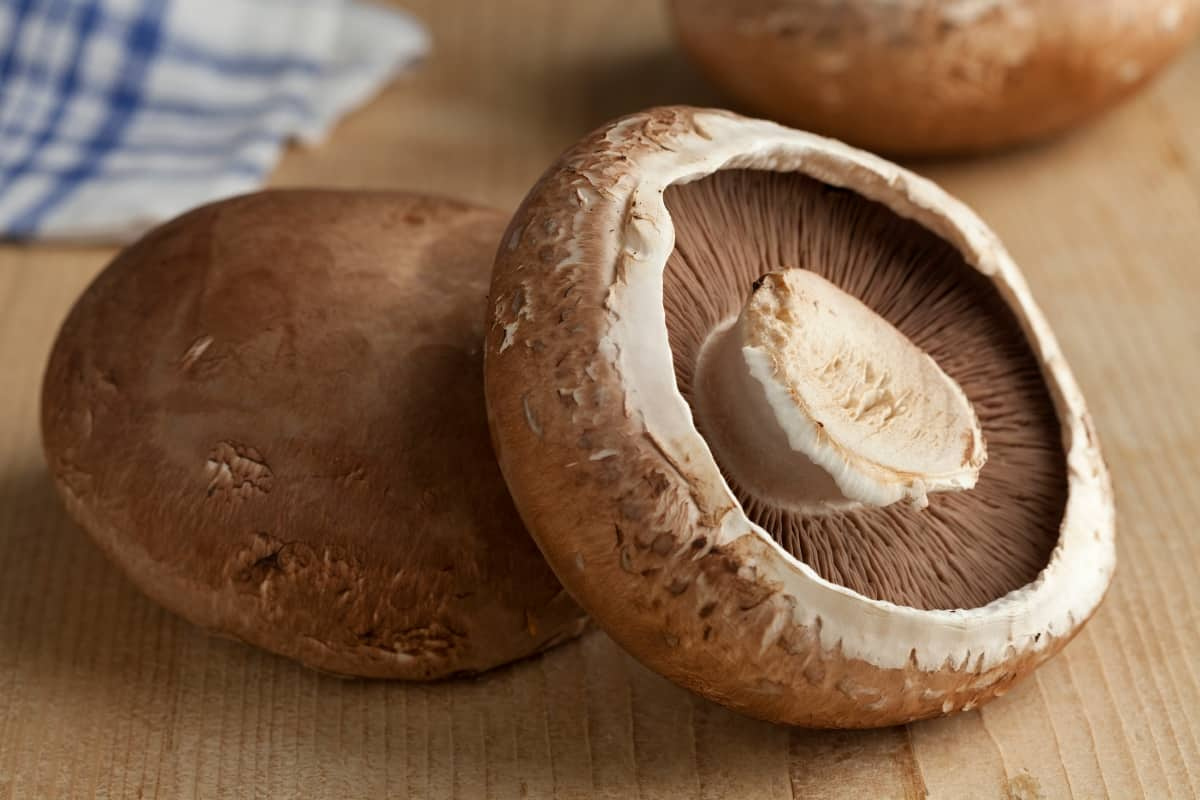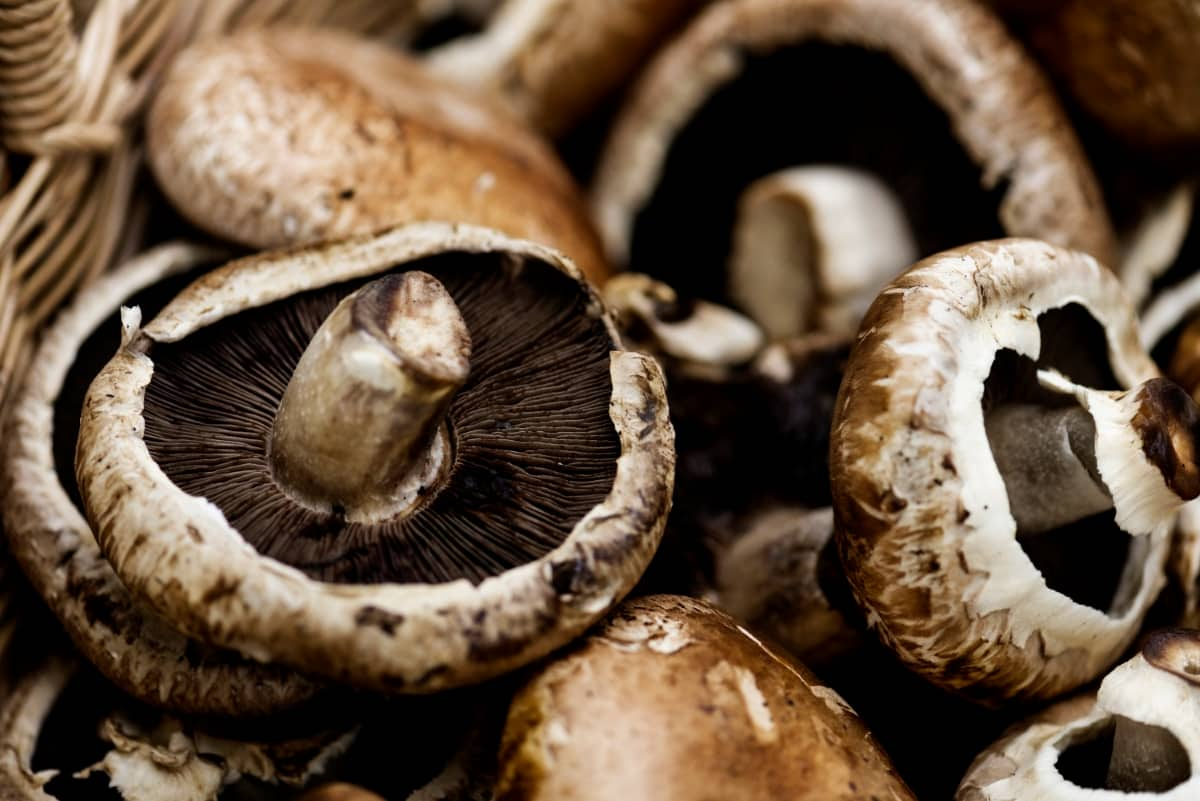Portabella mushrooms (Agaricus bisporus), also called cremini mushrooms, crimini mushrooms, white buttons, brown mushrooms, or baby bella mushrooms, are widely grown edible mushrooms. It comes in brown, white, and off-white forms and is sold under various names and at varying stages of maturity. It grows naturally in grasslands worldwide and is commercially grown in many countries. Mushrooms of all colors and sizes are loved for their umami-rich taste and texture.

Growing Portobello Mushrooms
Understanding the Ideal Humidity Levels for Growing Portobello Mushrooms
Understanding the ideal humidity levels for growing Portobello mushrooms is crucial for successful cultivation. These mushrooms thrive in a relatively high-humidity environment, with humidity levels of about 85%. Maintaining proper humidity levels is important as it promotes optimal growth and prevents issues such as drying out or excessive moisture.
To achieve the ideal humidity, growers can utilize methods such as misting the growing area with water or using a humidifier. Regularly monitoring humidity levels is essential to ensure the mushrooms receive the right conditions for healthy development. Growers can maximize their Portobello mushroom yields by understanding and maintaining the ideal humidity levels.
The Role of Temperature in Successful Portobello Mushroom Cultivation
Portobello mushrooms require specific temperature conditions to grow optimally. The ideal temperature range for cultivating Portobello mushrooms is 10 °C to 21°C. This range provides the necessary warmth for mycelium growth and subsequent fruiting. Temperatures outside this range can hinder the growth and development of the mushrooms.
High temperatures can lead to excessive moisture loss, resulting in stunted growth and poor-quality mushrooms. On the other hand, low temperatures can slow down growth and delay fruiting. Therefore, maintaining the correct temperature is crucial for successful Portobello mushroom cultivation.
Exploring the Different Growth Stages of Portobello Mushrooms
The first stage is the spawn stage, where the Portobello mushroom spores germinate and form mycelium. This mycelium then grows and develops into the next stage, called the pinning stage. During this stage, small pin-like structures known as primordia appear. These primordia eventually develop into fully formed mushrooms in the next stage, the fruiting stage. At this point, the mushrooms continue to grow and reach their full maturity. Harvesting Portobello mushrooms during the fruiting stage is important to ensure optimal flavor and texture.
Common Problems and Challenges in Growing Portobello Mushrooms
Contamination: One of the major challenges in growing Portobello mushrooms is contamination by mold, bacteria, or other pathogens. To prevent contamination, maintain a clean and sterile environment. This includes using sterilized equipment, properly pasteurizing the growing substrate, and implementing good hygiene practices.
Poor Mushroom Spawning: It occurs when the mycelium, the vegetative part of the fungus, fails to colonize the substrate properly. Inadequate colonization can result from improper temperature, incorrect moisture levels, or insufficient nutrition. To address this issue, it is essential to maintain optimal environmental conditions and ensure that the substrate is adequately prepared with the necessary nutrients.
Inconsistent Fruiting: Various factors can influence fruiting, including temperature, humidity, light exposure, and air circulation. To promote consistent fruiting, it is important to maintain stable environmental conditions, provide proper lighting, and ensure adequate air exchange in the growing area.
Pests and Diseases: Although portabella mushrooms are typically unyielding to pests and diseases, checking on your plants for any indications of such issues is recommended. Inspect your mushrooms regularly for usual pests like slugs, snails, and insects; if required, take the necessary steps to control them. Uproot the affected mushrooms to avoid spreading diseases to the remaining flush of mushrooms if you spot any disease symptoms, such as discoloration or decay.
Choosing the Right Substrate for Portobello Mushroom Cultivation
Choosing the right substrate for Portobello mushroom cultivation is crucial for a successful harvest. The substrate serves as the growing medium for the mushrooms and provides the necessary nutrients. One popular option is composted horse manure, rich in organic matter and nutrients. It is important to ensure the horse manure is properly composted to avoid contamination. Another option is a mix of straw and gypsum, which balances moisture retention and drainage.
In case you missed it: How to Grow Pink Oyster Mushroom: Facts, Humidity, Temperature, Growth Stages, and Problems

This substrate should be sterilized before use to prevent any unwanted pathogens. Ultimately, the choice of substrate depends on the availability, cost, and suitability for the specific cultivation environment. Last but not least, growing mushrooms from stem in coffee grounds. Using freshly used coffee grounds and boiled straw as substrate (the soil) and mixing them with mushroom spawn is one of the methods used by many urban farmers and “do-it-yourself” growers.
Spawning and Spawn Run: Initiating the Growth Process
Spawning refers to introducing mushroom mycelium into a substrate, such as compost or soil. This mycelium acts as a network of tiny threads, which will eventually give rise to the mushroom fruiting bodies. During the spawn run, the mycelium rapidly colonizes the substrate, breaking down organic matter and forming a dense mat. This mat serves as the foundation for the mushroom’s growth and development.
A suitable substrate is prepared and inoculated with a spawn to initiate the spawn. The spawn is typically composed of grain that the mushroom mycelium has colonized. Once introduced, the mycelium expands and spreads, utilizing the available nutrients. The spawn run usually lasts for several weeks, during which the mycelium establishes itself and prepares for the formation of mushrooms.
Casing and Pinning: Encouraging Fruit Body Formation
Casing and pinning techniques promote fruit body formation in Portobello mushrooms. Casing refers to covering the mushroom substrate with a layer of nutrient-rich material, such as peat moss or a mixture of vermiculite and peat. This layer provides the necessary moisture and nutrients for fruit body development.
Conversely, pinning involves the initiation of tiny mushroom primordia or pins, which eventually grow into mature mushrooms. Adequate humidity, temperature, and light conditions are essential for successful pinning. By implementing these practices, growers can create optimal conditions for the growth and development of Portobello mushrooms, resulting in a bountiful harvest.
Harvesting and Storage Techniques for Fresh Portobello Mushrooms
Do you know How Long Do Portobello Mushrooms Take to Grow? For portabella mushrooms to reach maturity, it generally takes about three to four weeks. Harvesting Portobello mushrooms when the caps are fully expanded but before the gills turn dark is recommended for optimum results. To ensure proper storage, keep them in a cool and dark place, such as a refrigerator, with a temperature range of 1-3°C and relative humidity of 85-90%. It is essential to store Portobello mushrooms in a breathable container or perforated plastic bag to prevent excess moisture buildup.
Troubleshooting Tips for Dealing With Issues in Portobello Mushroom Cultivation
Check the temperature and humidity in the growing environment if your mushrooms are not growing. Portobello s thrive in temperatures around 10 °C to 21°C and humidity levels of 85%. Inadequate moisture can lead to dry or malformed mushrooms, so ensure proper misting or watering of the growing medium.
In case you missed it: Benefits of Mushroom Compost in Gardening: How to Make at Home and Use for Plants

Fungal diseases can be a problem, so practice good hygiene and maintain proper air circulation. If you encounter pest infestations, consider using organic pest control methods. Regularly inspecting your crop and taking immediate action can help ensure successful Portobello mushroom cultivation.
Conclusion
Growing Portobello mushrooms can be a rewarding experience for enthusiasts. By understanding the facts, humidity and temperature requirements, growth stages, and potential problems, you can create an optimal environment for successful cultivation. Remember to maintain proper conditions, practice good hygiene, and address issues promptly to ensure a bountiful harvest of delicious Portobello mushrooms.
- Feed Your Flock for Less: Top 10 Tips to Save on Chicken Feed
- Ultimate Guide to Ossabaw Island Hog: Breeding, Raising, Diet, and Care
- Hatching Answers: The Top 10 Reasons Your Chickens Aren’t Laying Eggs
- Eggs and Economics: Breaking Down the Cost of Raising Backyard Chickens
- Defend Your Greens: Proven Methods to Keep Iguanas Out of Your Garden
- Ultimate Guide to Cinnamon Queen Chicken: A Comprehensive Guide for Beginners
- Ultimate Guide to California Tan Chicken: Breeding, Raising, Diet, Egg-Production and Care
- Ultimate Guide to Marsh Daisy Chicken: Breeding, Raising, Diet, and Care
- 10 Types of Chicken Farming Businesses You Can Start for Profits